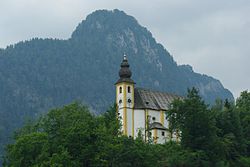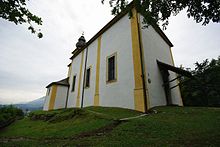St. Pankraz (Karlstein)
| Catholic pilgrimage church of St. Pankraz "Pankrazkirche" |
|
|---|---|
 Exterior view from the north |
|
| Data | |
| place | Bad Reichenhall , Schmalschlägerstr. 15th |
| builder | Lorenzo Sciasca |
| Construction year | 1687-1689 |
| height | 600 m |
| Floor space | 320 m² |
| Coordinates | 47 ° 43 '9.9 " N , 12 ° 50' 34.4" E |
The Catholic pilgrimage church of St. Pankraz is located on the so-called Pankrazfelsen in Karlstein near Bad Reichenhall . It is supported by the newly founded kath. Stadtkirche Bad Reichenhall looks after and is dedicated to St. Pankratius consecrated. In the vernacular and on most of the signposts it is simply called Pankrazkirche .
location
The church is located 145 meters above the valley floor on the Pankrazfelsen, which is in front of the Karlstein castle ruins . It can be reached from the north from Schmalschlägerstraße via a path with 264 steps.
On the north flank of the rock, directly below today's church, there were numerous dwellings from the Bronze and Urnfield Ages , which are part of the prehistoric settlement areas of Karlstein . On the Haiderburgstein, which rises northeast of the church of St. Pankraz, dwellings from the Bronze and Urnfield Ages were found. Presumably the area in which the church is located was also inhabited at that time. However, since the area was built over in the Middle Ages, there is no archaeological evidence. Between the church and Haiderburgstein there was also a cemetery from the urnfield era.
history
prehistory
Church cult buildings in today's Karlstein were mentioned for the first time in 1130. Archbishop Konrad I of Salzburg donated a fief near Kirchberg for the church of St. Georg in Kirchberg, which he had consecrated . After the building disappeared in the 16th century, its patronage was changed to that of St. Martin dedicated to the nuns church . The castle chapel of the Karlstein castle ruins , which has also disappeared, was dedicated to St. Consecrated to Andreas. The influence of Salzburg and the Counts of Peilstein seems to have been decisive for this.
Church patron
On August 1, 1427, Archbishop Eberhard IV of Salzburg declared that the consecration of the Pankrazkirche at Karlstein Castle was celebrated on Alexius's Day (July 17). Since then, St. Pankraz has been documented as the church patron. In the 15th century, the Pankrazkirchlein enjoyed various pious foundations. The civil marriage people Wilhelm and Margaret Sprengel donated 1450 two Tagwerk meadow at Reichenhall, 1485 sold Ritter Hanns of Haslang to mosses of St. Pancras Church five guilders annual Applies from his tower Rutzenlachen in Reichenhall. In 1487 this pension was redeemed for a payment of 100 guilders. A calendar of the St. Zeno monastery records a pilgrimage of the parish of Marzg to St. Pankraz on May 3, 1619 . As a result, the little church increasingly developed into a place of pilgrimage. Therefore, the Bavarian Elector Ferdinand Maria approved in 1673 that a clergy from St. Zeno was allowed to read a weekly mass in the Pankrazkirche during the summer months. Even today numerous votive pictures remind of the once blooming pilgrimage.
New building
The donations of the pilgrims and the economic strength of the St. Zeno Abbey allowed a new building from 1687 to 1689. In mid-August 1686, the Welsh Pau = or mason master Lorenzo Sciasca from Graubünden visited the previous church. On the cost estimate he submitted on September 2 for the demolition of the old and the construction of the new church, including carpentry, glazing and locksmith work, he received the order to build the church. For the construction, the difficulties of the material supply were overcome by the construction of a separate elevator. On July 7, 1689, the building was completed to the point where services could be celebrated. In the following years the interior was completed. The altars are attributed to the Reichenhaller sculptor Johann Schwaiger (1657–1734), a pupil of the Salzburg master Wilhelm Weissenkirchner, the setting to the Reichenhaller painter Martin Pöck. It is not clear whether the original pilgrimage picture has disappeared or was baroque by Schwaiger. In 1748 a way of the cross was added and consecrated by P. Jucundian Lechner. At the beginning of the 19th century the church almost fell victim to hasty decisions. The dean of Reichenhall, who had been in office since 1815, wanted to have it canceled due to alleged disrepair. It is only thanks to the persistence of the Karlstein farmers, who resolutely opposed the demolition of their church, that a commission of inquiry was delegated. This commission could not find any dilapidation and the demolition did not take place. In the 19th century, St. Pankraz was the richest church in the entire deanery (1880: 225,266 gold marks ) and was therefore often used for all other churches in the form of loans. In July 1973 St. Pankraz was attacked by church robbers who stole numerous valuable works of art. 1981-82 took place under the parish priest Helmut Eisele a comprehensive renovation.
description
On the way to the church there is a cross with Our Lady of Sorrows , a Lourdes grotto , a figure of the plague patron St. Roch and a group of Mounts of Olives . At the eastern end of the rock spur on which the church is located, there is a cross with the inscription God and Science in thanks with a coat of arms.
Exterior
The St. Pankrazkirche is a simple baroque hall church with a retracted, semicircular closed choir. In the north and south there are three rectangular windows with a marble border, the walls are structured by painted pilasters . In the north, transverse ox eyes serve as the light source for the choir , underneath is the sacristy building with a window to the north and east. To the east of the end of the choir is the Salzburg-style domed tower with three tapered helmets and a structure with painted pilasters on all floors. All roofs are covered with wooden shingles. The facade is kept simple and decorated with painted corner pilasters and cornices . The marble portal has a broken gable, in the middle of which there is a ball on a pedestal .
Interior
The nave has three bays , the choir one. The barrel vault rests on narrow pillars and a strong cornice, which is set off twice in the choir area. The structure of the vaults by the belt arches and the cornices are overemphasized by the ocher yellow. The magnificent high altar is located in the choir apse , the two side altars in the arch. A pulpit is attached to the north wall of the nave . The organ gallery rests on two wooden pillars with high plinths.
Furnishing
A splendid high altar from 1690, somewhat later side altars and a far-reaching pulpit by the Reichenhall sculptor Johann Schwaiger. The altars are prime examples of the Salzburg altar type with black architecture, colored figures and gold-plated ornaments. The main altar bears in the middle part the figure of the church patron in full armor with a lance and shield, flanked by the two fellow patrons with their attributes, St. Emperor Heinrich on the right and St. Alexius on the left. In the choir there are four pictures depicting Judith , Ester , David and King Solomon . There are also two flags for the processions, one with the Saints Pancratius, Heinrich and Alexius, the second with Sebastian , Magdalena , Alexius and Pancratius on the back. The right side altar is St. Magdalena consecrated, the left to the plague patron Sebastian. Between the side altars there is a mighty choir cross from 1700 on the ceiling. The pulpit carries the two stone tablets with the will of God, surrounded by clouds and rays, on the sound cover. Above the preacher the Holy Spirit , on the parapet in four fields the evangelists on canvas . The choir stalls and the main stalls are kept simple, the cheeks painted. The organ from 1950 in an old case has seven registers and comes from Julius Zwirner in Munich .
The Way of the Cross with carved frames, which is distributed over the whole church, dates from 1748.
On the north wall a votive picture with the Mother of God and St. Albert , including the sick and dying. Under the pulpit a picture of St. Peter in a simple frame, followed by an Anna herself third with Holy Spirit.
On the south wall in the first yoke a votive picture from 1693 with Mary as a protective mantle Madonna , with St. Benedict and St. Pancratius. On the pillar is the Innsbruck miraculous image (originally by Lucas Cranach ), in the corner of St. Martin .
In the spandrels above the windows there are two painting cycles, the first of which depicts the death of man, his judgment, the adoration of the Trinity and the condemnation in hell. The second cycle shows the life of Mary with the Immaculate , Mary with child and St. Joseph and Johannes , Benedict and Scholastica and the coronation of the Mother of God.
The church has 44 other votive pictures, the oldest in the sacristy from 1672, all others from the period from 1698 to 1810 under the organ gallery.
The holy water font is made of marble with an oval bowl and a structured base.
There are two bells in the church, the oldest (still from the old church) next to the high altar around 1400, the second under the organ gallery, cast by Andreas Gartner from Salzburg in 1689 and consecrated to the altar sacrament of Mary.
Todays use
Because of the shortage of priests and poor accessibility, masses are rarely held on St. Pankraz. In general, these are still the patron saint , the May devotion , Thanksgiving and alternating with St. George in Nonn the Christmas mass . Even weddings and christenings rarely happen. Nevertheless, the building is in good condition and the rock offers a good view of Karlstein and the city of Bad Reichenhall.
literature
- Hubert Vogel: About the four-thousand-year-old Karlstein , Munich 1973
- Walter Brugger: The churches of the parish of St. Nikolaus Bad Reichenhall (= Small Art Guide No. 2043). Schnell and Steiner, Regensburg 1994, ISBN 3-7954-5781-5







